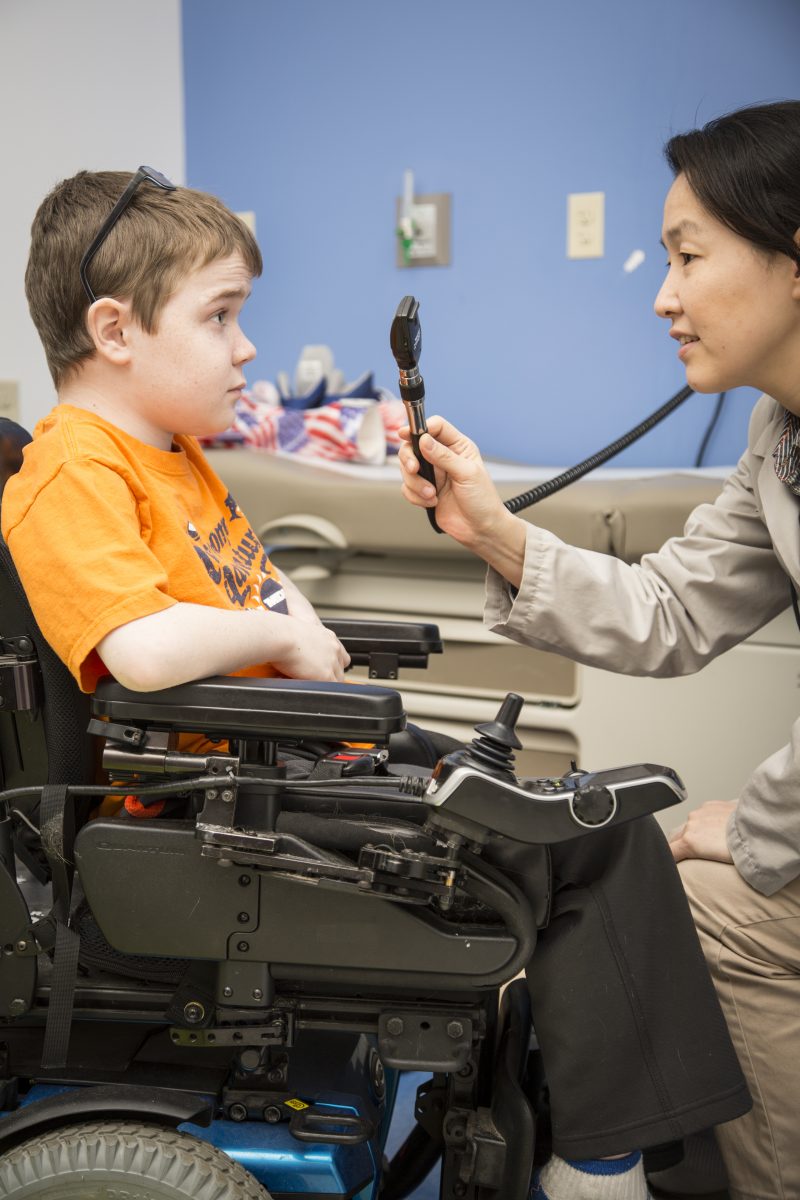The Challenges of Gene Therapies in Treating Diseases Such as Friedreich’s Ataxia: Talk With MDA

A child being examined at an MDA care center. (Photo courtesy of the MDA)
Gene therapies — after a tragedy kicked them back to the lab two decades ago — are beginning to come into their own, making possible the progress in gene-targeted and combination treatments for neuromuscular diseases once thought unimaginable.
But many challenges remain — from the likelihood of no “one and done” gene therapy existing for diseases such as Friedreich’s ataxia, Pompe, or muscular dystrophy, to the sheer amount of vector needed for both system-wide and central nervous system treatment — especially for rare neuromuscular disorders, said Sharon Hesterlee, PhD, an executive vice president and chief research officer for the Muscular Dystrophy Association (MDA).
Jesse Gelsinger’s death in a gene therapy trial in September 1999 “really set the whole field back for a long time,” Hesterlee said in a wide-ranging phone interview with Bionews Services, the parent company of this website.
But the MDA “continued to invest … through that whole dry period, with the thought that this is going to work. We just have to figure out how.”
Hesterlee has a more than 20-year career in the pharmaceutical and biotech industries as well as nonprofits (including with the MDA, where she worked in drug translation and venture philanthropy from 1998 to 2009).
She welcomes gene therapy’s return, and some sense of accomplishment for the more than $1 billion the group has invested in neuromuscular disease research since its founding in 1950.
“Now we’re seeing the maturation of that [gene] technology, a much better understanding of the issues, and we’re starting to see successes,” she said.
She, like others, points to the U.S. approval of the first gene therapy in a neuromuscular disease — Zolgensma, by Novartis, for spinal muscular atrophy (SMA) — as an initial breakthrough and a sign of what might come.
And she highlights her nonprofit group’s work to support research, from early discovery through to late-stage development. The MDA gave out $16.8 million in direct research grants in 2019 (part of a total $66 million multi-year funding commitment), and anticipates awarding about $18 million in direct grants in 2020, Hesterlee said.
Translating Zolgensma’s success to other patients, however, will take time.
Two big challenges, but glimmers of hope
Two broad challenges exist for gene therapies in neuromuscular ills, especially rare ones, Hesterlee said, with numerous mini-hurdles within those categories.
One is getting the therapy to all affected muscles and organs and, along with that, being able to produce the huge amounts of viral vector required to transport it.
As one recent study of work into a Pompe gene therapy, by scientists that include Barry Byrne, MD, PhD, and Manuela Corti, PhD, at the University of Florida (UF), noted: the vector amounts necessary exceed current production techniques on a scale that would not be suitable to support either Phase 3 clinical trials or regulatory approval requests.
The other is the real likelihood that such treatments would have to be given again over a person’s lifetime, which means getting around resistance raised by the immune system. An immune response to a gene therapy comes in the form of antibodies against whatever virus carries the “healthy gene” to cells as a transport vector, even when that virus is re-engineered to be harmless.
“I think we know we’re going to have to treat people again, and right now what we’ve done is immunize them against the vector,” Hesterlee said. “They’re developing really high antibodies after treatment, so you can’t use the same vector.
“I think that’s going to be a big, big challenge: How do we deal with people that have pre-existing antibodies, and then how do we deal with redosing?”
The challenge of knowing whether Zolgensma is truly a one-time SMA treatment remains. A gene therapy is likely to be much more stable in the central nervous system (CNS, comprising the brain and spinal cord) than in muscle, Hesterlee said, but only time will definitively tell.
“People speculate ‘one and done‘ [but] we know that might not be the case,” she said. “We just don’t have enough long-term data to really understand how long this lasts in muscle, how long this lasts in the CNS.”
Scientists are meeting these challenges head-on. Hesterlee mentioned a Phase 1 trial (NCT02240407) underway by Byrne and others at UF that is redosing people with late-onset Pompe disease, using a immuno-suppression regimen described in a recent study.
Cooperation across private interests and nonprofit patient groups such as the MDA is also coming to the fore. Examples include a first multi-drug, or platform, clinical trial for a neuromuscular disease such as amyotrophic lateral sclerosis — the Healey ALS Platform Trial — and growth in collecting and sharing comprehensive patient data, like the MOVR registry that the MDA is establishing.
“It really does make sense that you want to bring as many resources together as possible in rare disease spaces. You can’t duplicate resources,” Hesterlee said.
Meanwhile, less rivalry is evident across companies, institutions, and associations, and that’s a huge leap, she said.
“People are starting to share the datasets they used to horde. I think all of this … bodes well for the future.”
Work underway in Friedreich’s ataxia
AavantiBio, co-founded by the University of Florida’s Byrne and Corti in 2017 specifically to better treat Friedreich’s ataxia, is planning to open a Phase 2 gene therapy trial later this year. The effort is supported by a $1-million grant from the MDA.
Neurocrine Biosciences and Voyager Therapeutics also partnered to advance a separate gene therapy, called VY-FXN01, into clinical testing.
The progressive damage to nerves and muscles that marks FA is caused by mutations in a single gene, FXN, affecting production of the frataxin protein. As such, it’s an ideal disease for gene-targeting therapy, at least in theory.
But this neuromuscular disease is complex and includes CNS involvement, because the absence of frataxin causes damage to the nerves that carry signals between the muscles and the brain. That means whatever vector is used to treat FA will need to deliver a “replacement gene” to vastly different groups of cells.
“Friedreich’s ataxia is a challenging disease to treat with gene therapy because you’ve got both CNS symptoms and the peripheral muscle and the heart challenges as well,” Hesterlee said. “You have a lot of targets.”







